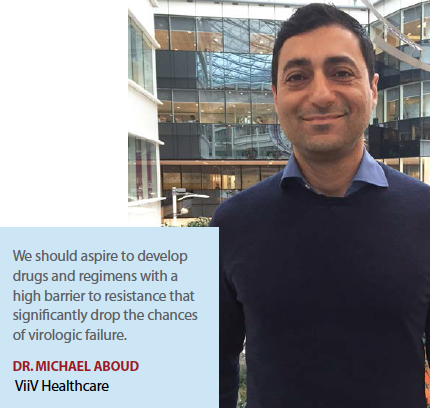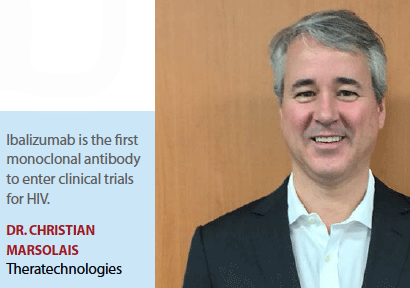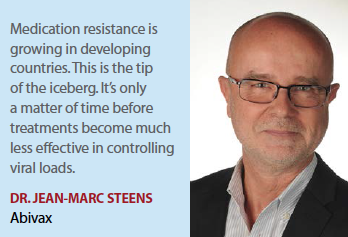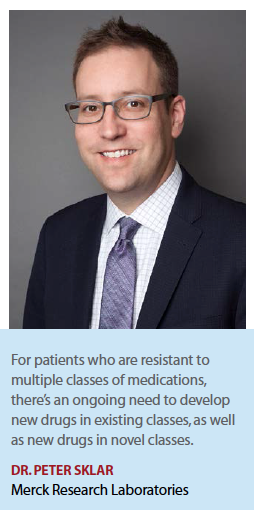 Since the beginning of the HIV epidemic, almost 70 million people worldwide have been infected with the virus that causes AIDS. It is estimated that 36.7 million people are currently living with HIV globally.
Since the beginning of the HIV epidemic, almost 70 million people worldwide have been infected with the virus that causes AIDS. It is estimated that 36.7 million people are currently living with HIV globally.
Tremendous gains have been made in treating these patients, helping them to live longer, healthier lives. Antiretroviral drugs have been credited with reducing deaths from HIV and AIDS. These drugs fight HIV by stopping or interfering with the reproduction of the virus in the body, reducing the amount of virus in the body, and slowing the progression of HIV. Increasingly, people living with HIV generally can remain well for an extended period of time.
A July report by the World Health Organization (WHO) and UNAIDS found that an estimated 17 million people were accessing antiretroviral medicines at the end of 2015. In fact, the WHO’s efforts to scale up antiretroviral treatment since 2010 have reduced AIDS-related deaths from 1.5 million in 2010 to 1.1 million in 2015. But these numbers account for only 46% of people who are eligible for treatment, according to the WHO.
Efforts to address medication adherence, which has the best chance for quality of life, are having a positive impact on not only keeping those infected with HIV well but holding down rates of drug resistance. HIV patients face a number of adherence hurdles, such as side effects like nausea or diarrhea, which can impact patients’ quality of life, and some HIV regimens require a complicated array of pills. If medications are not taken properly or if doses are missed, the virus can potentially replicate and mutate.
There’s no doubt that newer medications and drug cocktails are easier for patients to take, which in turn helps to keep the virus in check and prevents drug resistance.
“Better and more tolerable agents, more convenient regimens, and enhanced support programs for patients are helping to improve long-term adherence," says Brian Woodfall, M.D., global head, late development, infectious diseases and vaccines, Janssen Pharmaceutical.
 A secondary effect of this, Dr. Woodfall says, is a decrease in transmitted resistance, or resistance to HIV medication that is already present when a person becomes infected with the virus.
A secondary effect of this, Dr. Woodfall says, is a decrease in transmitted resistance, or resistance to HIV medication that is already present when a person becomes infected with the virus.
“In the 1990s, drug resistance was problematic for patients who had not even yet started drug therapy, and there were limited therapeutic options available for those patients," he says. “As the pool of resistance has decreased, there’s also been less transmission of resistance, although that resistance remains a threat for those who do not adhere 100% to their treatment regimen."
Industry experts say drug resistance is still a concern within the medical community for many reasons. In the United States, the incidence of new HIV infection is on the rise, particularly in the adolescent population, those 13 to 22 years old.
“Although resistance is down right now, there is the potential for this to change, either at an individual or a population level, at any time," says Richard Nettles, M.D., VP, U.S. medical affairs, Janssen Infectious Diseases.
Additionally, the WHO found that in many low- and middle-income countries, many patients were missing routine checkups and disappearing from patient records. On average, 20% of patients were missing in patient records within a year since treatment initiation, and some 73% of patients were not retained on treatment. The report also shows that 36% of surveyed clinics experienced interruptions in the supply of antiretroviral drugs.
“In developing countries, despite the fact that drug access has become much better, sometimes there are still no drugs available because they’re out of stock in the pharmacies," says Jean-Marc Steens, M.D., chief medical officer, Abivax. “But this is just the tip of the iceberg. Even in patients who are well-controlled, based on their genetic profile, they are starting to develop resistance, and unfortunately this could lead to their treatment becoming much less effective in controlling the viral loads."
In western countries, the threat is less because patients can be monitored closely to ensure that viral loads remain undetectable and they can be tested for drug resistance.
“Because we in the West intervene early, we can limit the extent of resistant mutation that will be generated upon virologic failure," points out Michael Aboud, M.D., global medical lead for dolutegravir at ViiV Healthcare. “In research- limited settings, the monitoring of viral load testing and resistant testing is patchy at best and in many settings testing is not available at all. Therefore, we expect that many patients are failing on their therapies and becoming treatment resistance, but the extent of this picture is not very clear."
limited settings, the monitoring of viral load testing and resistant testing is patchy at best and in many settings testing is not available at all. Therefore, we expect that many patients are failing on their therapies and becoming treatment resistance, but the extent of this picture is not very clear."
The WHO is recommending a five-year Global Action Plan on HIV drug resistance to support a coordinated international effort to prevent, monitor, and respond to the emergence of HIV drug resistance and to strengthen efforts to achieve global HIV targets.
In fact, in one study published in the Lancet Infectious Diseases in January 2016, researchers found that resistance to the antiretroviral drug tenofovir, Gilead’s Viread, is increasingly common. The researchers were concerned because the drug plays a major role in treating and preventing infection with HIV.
For the study, the investigators looked at more than 1,900 HIV patients worldwide who had uncontrolled HIV despite taking antiretroviral drugs. Tenofovir-resistant HIV strains were found in 60% of patients in sub-Sahara Africa. This compares with just 20% of patients in Europe with tenofovir-resistant strains. About-two thirds of patients with tenofovir-resistant HIV also had resistance to other drugs used in their therapy.
Research of Drug Resistant HIV
GSK and ViiV Healthcare have been leaders in the research and development of HIV drugs since the 1980s, with the development of Retrovir (zidovudine). ViiV Healthcare, established in 2009, is a specialist global HIV company, majority owned by GSK, with Pfizer and Shionogi as other shareholders.
 In December 2015, ViiV Healthcare acquired from Bristol-Myers Squibb late-stage HIV R&D assets, including fostemsavir and various maturation inhibitor candidates, as well as its portfolio of preclinical and discovery stage HIV research assets.
In December 2015, ViiV Healthcare acquired from Bristol-Myers Squibb late-stage HIV R&D assets, including fostemsavir and various maturation inhibitor candidates, as well as its portfolio of preclinical and discovery stage HIV research assets.
“We acquired a number of interesting molecules and highly qualified personnel," Dr. Aboud says. “We now have an in-house discovery unit that complements the discovery unit at GSK. This has enabled us to look at the unmet needs in HIV and be critical in terms of the products we develop from this pipeline and bring to market for unmet needs."
One of the more advanced products acquired from BMS is fostemsavir, an attachment inhibitor, currently in Phase III development for heavily treatment-experienced patients who developed resistance to multiple classes. Fostemsavir has received a Breakthrough Therapy Designation from the FDA and is expected to be filed for regulatory approval in 2018.
“Fostemsavir could have a high barrier to resistance and is specifically developed to address the unmet need for patients who have failed many regimens before and have resistance to multiple classes," Dr. Aboud says.
Another later-stage product is a maturation inhibitor (BMS-955176), currently in Phase IIb development for both treatment-naive and treatment experienced patients.
Assets in preclinical and discovery phases of development include a novel biologic (BMS-986197) with a triple mechanism of action, an additional maturation inhibitor, an allosteric integrase inhibitor, and a capsid inhibitor.
Theratechnologies, a specialty pharmaceutical company also developing therapies for drug-resistant HIV, completed trials of a new therapy specifically to treat multi-drug resistant HIV. In November 2016, the company released preliminary results for the safety and efficacy secondary endpoints of a 24-week Phase III trial with ibalizumab in patients with multi-drug resistant (MDR) HIV-1 (TMB-301).
This Phase III trial confirms the safety and efficacy results of ibalizumab observed in the previously completed Phase IIb study, despite the fact that the patient population in the Phase III trial had higher levels of MDR HIV-1 and more advanced disease at time of enrollment.
 In the trial, after 24 weeks of treatment, 48% of patients had a reduction in viral load of more than 2.0 log during this period.
In the trial, after 24 weeks of treatment, 48% of patients had a reduction in viral load of more than 2.0 log during this period.
Unlike other antiretroviral agents, ibalizumab, a humanized monoclonal antibody, binds primarily to the second extracellular domain of the CD4 receptor. It potentially prevents HIV from infecting CD4+ immune cells while preserving normal immunological function. Ibalizumab is active against HIV-1 resistant to all approved antiretroviral agents.
“Ibalizumab, the first monoclonal antibody to enter clinical trials for HIV, blocks the entry of the virus in the cell," says Christian Marsolais, Ph.D., senior VP and chief medical officer, Theratechnologies. “It doesn’t necessarily block the attachment of the virus to the cell but it blocks the following step and doesn’t allow the virus to enter the cell. With a sufficient dose, all of the receptors on the CD4 will be saturated with ibalizumab, therefore blocking the entire entry of the virus in all of the CD4."
These results support the submission of the biologics license application (BLA) to the U.S. FDA and the next step is the completion of the regulatory submission by Theratechnologies’ partner TaiMed Biologics. Ibalizumab has an FDA breakthrough designation, and the company plans to file with the agency in the first quarter of 2017.
HIV Research Trends
Merck is another company that has been researching HIV since the 1980s when HIV/AIDS was first identified. The company’s Crixivan (indinavir), a protease inhibitor, was approved in 1996. At the time, the FDA’s approval of Crixivan was the fastest approval in FDA history.
In the early 1990s, Merck was the first to demonstrate that inhibition of the HIV-1 integrase enzyme — which is required for HIV replication — was possible, and that inhibiting the integrase protein reduced replication and spread of the virus. This research advancement led to the development of Isentress (raltegravir). In 2007, the approval of Isentress introduced a new class of treatments, HIV-1 integrase.
“Even as many companies have moved away from HIV research, Merck has doubled down on its research, both in terms of treatment and prevention, as well as efforts to attempt to find a cure for HIV," says Peter Sklar, M.D., M.P.H., director, clinical research at Merck Research Laboratories. “Our research program has evolved over time beyond just treating patients who have HIV to potentially curing those patients, as well as looking at ways that we can prevent patients who are at risk from ever becoming HIV infected."
Merck’s research efforts today include development programs focused on novel HIV treatments and prevention technologies and collaborations to address HIV latency and eradication.
Merck is conducting Phase III clinical trials evaluating the safety and efficacy of once-daily oral doravirine, an investigational next-generation non-nucleoside reverse transcriptase inhibitor (NNRTI), plus tenofovir/emtricitabine (TDF/FTC) compared with efavirenz plus TDF/FTC in previously untreated patients with HIV-1 infection.
In addition, Merck is conducting Phase III trials to evaluate the safety and efficacy of doravirine vs. daruna plus ritonavir each in combination with Truvada or Epzicom in treatment-naïve HIV-1 infected patients.
Over the years, Merck has evaluated the drug classes that have proven to be the most effective and has used these as anchors for regimens.
“We saw many ways to improve upon the existing drugs and doravirine is a next generation NNRTI, and we’re exploring its potential use in a couple of different patient populations, primarily among treatment naïve patients, but also among patients who may not be satisfied or can’t tolerate their current regimens," Dr. Sklar explains.
He says the most common NNRTI-resistant viruses have a mutation at codon 103, 181, or 190, and in the test tube doravirine appears to be active against viruses that contain those particular mutations.
“In our clinical studies program exploring a switch to a doravirine-based regimen, we didn’t declare an exclusion for these specific resistance mutations," Dr. Sklar says. “We are curious to see in patients who have these mutations whether doravirine will be able to maintain suppression of the virus."
He says Merck is doing additional early research on other molecules that could address virus mutations.
“We think the newer generation of NNRTIs hopefully will be effective in patients who have NNRTI resistance," Dr. Sklar says. “For patients who are resistant to multiple classes of medications, there’s the ongoing need to develop new drugs in existing classes, as well as new drugs in novel classes. Although the development of these novel classes has become more challenging I think some of the obvious targets for drug development have been exploited. To me the greatest key to success moving forward is to continue to make medications that are easier to tolerate, because the way acquired drug resistance occurs is by poor adherence. If we make medications that are easier to adhere to, that is the best way to address that problem."
Janssen is another company committed to research and development of medicines to treat HIV infections. Through the acquisition of Tibotec in 2002 — the division changed its name to Janssen Therapeutics in 2011 — Janssen has been developing therapeutics for HIV, hepatitis C, and other infectious diseases.
Dr. Nettles says a recent focus for the company is to co-formulate medications. For example, Janssen’s Prezista (darunavir) was approved in 2006, and it must be used with a booster medication called ritonavir. In 2015, the company received U.S. approval for Prezcobix (darunavir/cobicistat) where the booster was co-formulated in the medication.
“This means patients only have to take one tablet instead of two, which makes adherence easier and lowers the chance of missed doses that could lead to the development of the HIV developing drug resistance," he says.
Janssen has also collaborated with Gilead for the U.S. approvals of Complera — a single pill combination of Gilead’s Truvada and Janssen’s Edurant — and Odefsey, a single pill combination of Gilead’s Descovy and Janssen’s Edurant. Odefsey was approved for U.S. marketing in March 2016 for the treatment of HIV-1 infection.
Dr. Woodfall says the company is also focusing on novel vaccine approaches.
In November, the company announced preclinical data showing that combining therapeutic vaccination with immune stimulation could be a potential way to achieve a functional cure for HIV infection.
In this study of primates, the strategy was to draw the virus out of hiding with the goal of eradicating it from the body. Researchers combined two investigational therapeutic vaccines (an adenovirus serotype 26 vector vaccine (Ad26) and an MVA vector vaccine (MVA)) with a TLR7 agonist (an investigational drug that works on a protein of the immune system) into a treatment regimen to be administered alongside ART.
When the treatment regimen was given, decreased levels of viral DNA in peripheral blood and lymph nodes were seen and there was improved viral suppression and delayed viral rebound when therapy was stopped.
Abivax is a biotechnology company also targeting the immune system to eliminate viral disease. ABX464, its most advanced compound, is currently in Phase II clinical trials and is a first-in-class oral small anti-viral molecule that blocks HIV replication through a unique mechanism of action.
ABX464 inhibits the biogenesis of viral RNA required for the replication of the HIV virus. Preclinical data suggest that ABX464 could induce long-term control of the viral load, be less frequently administered over a shorter period than standard treatments, and not induce HIV mutants that are resistant to treatment.
Dr. Steens says the technology behind the product is based on viral splicing, which is linked to protein synthesis and biogenesis of proteins through messenger RNA. In studies in mice, the viral load didn’t increase when the treatment with ABX464 stopped.
The low level of the virus remained six weeks after stopping the treatment. In another group of mice treated with triple anti-retroviral therapy saw the viral loads increase after treatment.
Dr. Steens theorizes there was an immune response that developed in the mice after treatment with ABX464.
The company is conducting trials in patients now in which they hope to see results similar to those in mice.
“These patients are fully suppressed with no viral load detectable," Dr. Steens says. “In this trial, we are adding to their treatment either ABX464 or placebo for a period of 28 days then all treatments are stopped. We will look to see when the viral load rebounds a post-treatment interruption. We hope to see results in line with what we saw in the mice data." (PV)


















